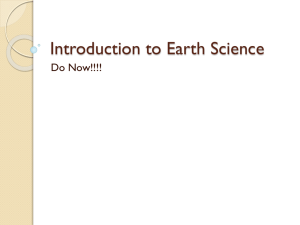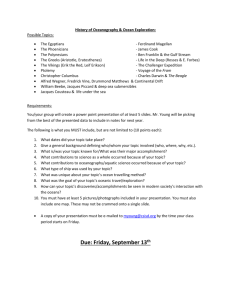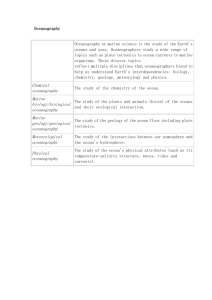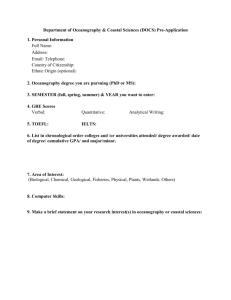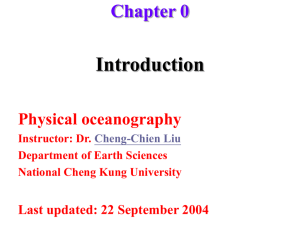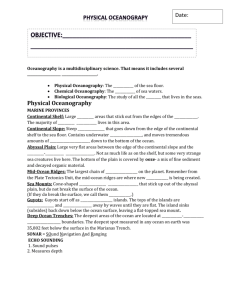History of Marine Science
advertisement
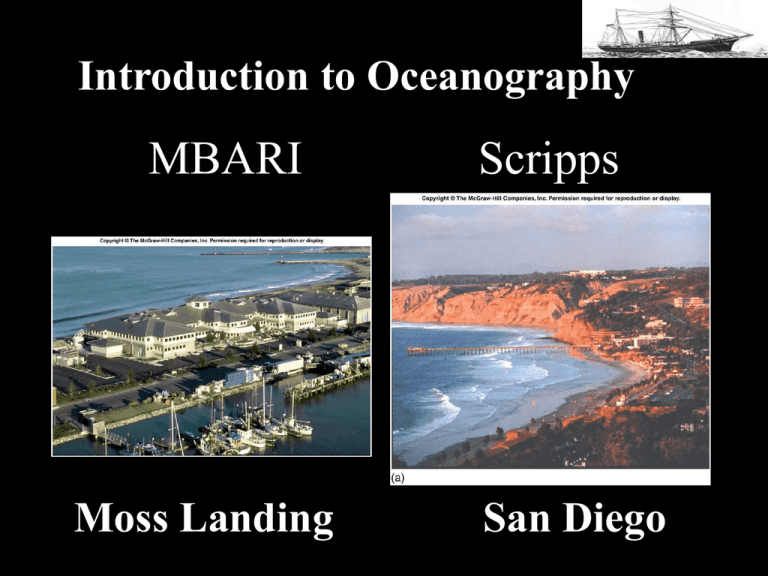
Introduction to Oceanography MBARI Moss Landing Scripps San Diego Oceanography The Science or Study of the Oceans • Geological Oceanography • Physical Oceanography • Chemical Oceanography • Biological Oceanography Geological Oceanography • Study of earth at edge of ocean • Formation processes (seafloor) • Sediments • Rocks & minerals • Geothermal vents Physical Oceanography • How & why oceans move • Weather • Heat transfer • Water cycles • Waves, tides, currents • Temperature Chemical Oceanography • Composition & history of seawater • Seawater processes & interactions • Salinity • Dissolved gases • Nutrients Biological Oceanography • Living organisms • Organisms relationships with each other and their environment Marine Sediments (geological) created by Living Organisms (biological) That are influenced by Nutrients (chemical) and Currents & Temperature (physical) History of Oceanography Early Times • Paleolithic and Neolithic periods – Hunting and food gathering: – Ohlone Indians on Central Coast of California • The Egyptians – Offshore fishing – Exploration- reed boats • The Phoenicians – Trade – Navy Early Explorers and Traders • Ancient Civilizations (1500 BC – 500 AD) • Interest in oceans driven by need to food and trading • Egyptians - shipbuilding and coastal piloting • Phoenicians – North Africa, excellent sailors; explored the Mediterranean, traded with Britain, • May have circumnavigated Africa around 600 BC • Arabs explored the Indian Ocean • Polynesians – explored Pacific Ocean From the ninth to sixth centuries B.C. they dominated the Mediterranean Sea, establishing emporiums and colonies from Cyprus in the east to the Aegean Sea, Italy, North Africa, and Spain in the west. Pharos Lighthouse at Alexandria One of seven wonders of the ancient world Recently found by marine archeologists Ancient Classical Knowledge • • • • • • • • • • Greeks: an intellectual curiosity about the oceans Aristotle (~350 BC) Treatise on marine organisms, observations of water cycle (hydrologic cycle) Library of Alexandria founded in 3rd century BC. housed “world’s knowledge” Eratosthenes (~ 200 BC): • 2nd librarian at Alexandria • Calculated earth’s circumference • Invented latitude and longitude lines Eratosthenes Fresco from the Palace of King Minos 1500BC Possible origin of “Atlantis” as volcanic eruption and tsunamis destroyed Minoan civilization near Crete The Polynesians: Explorers of the Pacific Ocean Polynesian Double-Hulled Canoe Dual hulled boats carried 100 people Skilled navigation wave action bird flight stars atmospheric conditions Polynesian double hull canoe Polynesian Sailing Canoes Polynesian Stick Map Migration routes of the Polynesians Goal: Water Person Hawaiian Style Hawaiians invented surfing Easter Island: deforested Civilization collapses Middle (Dark) Ages 400s – 1400s in Europe Extreme superstition Fear of intellectual inquiry Much information lost Map of Europe 600 AD The Middle Ages • Vikings – Improvements in shipbuilding – Trade and colonization • Arabs – Description of currents associated with seasonal monsoon – Trade routes to China – Preserved Greek and Roman knowledge • China – Compass – Trade routes to Persian Gulf • Europe – Increased knowledge of navigation – Tide tables • In 1405, Chinese sent 62 ships to explore the Indian and Pacific Oceans Vikings Age of Exploration 800-1066 AD Leif Erickson Discovered North America 500 years before Columbus Viking Long Boat Fig. 1.5 Modern day Vikings Vikings where did they go? Vikings view of their Inuit Neighbors Ptolemy’s Map of the World 150AD • Fig. 1.4 Ptolemy’s Map Still in use 1500 AD Age of Exploration 1480-1610 Voyages of Discovery • Early Chinese – Exploration of the Pacific and Indian Oceans • Europe – Prince Henry the Navigator • Naval observatory – – – – – Vasco da Gama Christopher Columbus Ferdinand Magellan Sir Martin Frobisher Francis Drake Fifteenth century routes of Bartholomew Diaz, Vasco da Gama, and Christopher Columbus Columbus: Hero or ? “Gold is most excellent; gold constitutes treasure; and he who has it does all he wants in the world, and can even lift souls up to Paradise.” – Christopher Columbus, 1503 letter to the king and queen of Spain. Navigational Chart of northern Europe from Johannes van Keulen’s Sea Atlas of 1682-1684 Sixteenth Century circumnavigation routes of Ferdinand Magellan and Sir Francis Drake Sir Francis Drake Great Explorer or Sea Devil? The Importance of Charts and Navigational Information • Trade, travel, and exploration • First hydrographic offices – France, 1720 – Britain, 1795 • Relationship between time and longitude – John Harrison; first chronometer The Importance of Charts and Navigational Information • Voyages of James Cook • Benjamin Franklin – Chart of Gulf Stream • National and commercial interests – U.S. Survey of the Coast set up in 1830 (now known as the U.S. Naval Oceanographic Office) James Cook (1728 – 1779) 3 major voyages mapped South Pacific, coasts of New Zealand, Australia and N America, “discovered” Hawaiian Islands Cook’s Voyages Ben Franklin’s Gulf Stream Map Why did Benjamin Franklin make his map? • First Postmaster General of U.S., he wanted to speed the mails across the Atlantic. “Dost thou love life? Then do not squander time, for that's the stuff life is made of.” “You may delay but time will not.” Franklin’s map and satellite photo of Gulf Stream “You may delay but time will not.” Benjamin Franklin 1860 Gulf Stream Map 1860 Gulf Stream Map What’s at the bottom of the Sea? Ocean Science Begins • Botanists and naturalists – Collect, describe, and classify organisms – Theory of atoll formation (Charles Darwin) – Investigations of microscopic drifting plants and animals (plankton) • Scientific interest based on practical reasons – Navigation, tide prediction, and safety • Importance of government support – Laying of transatlantic telegraph cables H.M.S. Beagle 1831-1836 Voyage of the Beagle, 1831-1836 First “true” oceanographer 1847 Maury 1847: U.S. Navy Lieutenant Matthew F. Maury produced first bathymetric, wind and current chart of the North Atlantic. The Challenger Expedition • Comprehensive scientific expedition • Naval corvette refitted with laboratories, winches, and sounding scope – – – – – – Circumnavigation 361 sounding stations Collected deep-sea water samples Investigated deep-water motion Temperature measurements at all depths Thousands of biological and sea-bottom samples Challenger Fig. 1.15 Expedition • Analysis and compilation of data continued for 20 years • Began oceanography as a modern science • Prestige stimulated expeditions by other nations Voyage of the Challenger, 1872-1876 Challenger Expedition Exploratory Science • Fridtjof Nansen – Voyage of the Fram – Nansen bottle • International scientific cooperation – Motivated by fluctuations in commercial fish • Antarctic exploration • Amundsen, Scott, Shackleton • Arctic exploration • Admiral Peary, Nansen Early Oceanographers Harsh conditions and slow work compared to today Oceanography in the Twentieth Century • • • • • • • • • Support by wealthy individuals Scripps Institution of Oceanography Woods Hole Oceanographic Institution Rapid advances during World War II Office of Naval Research (ONR) and National Science Foundation (NSF) funding International Geophysical Year (IGY) cooperation Satellites Deep Sea Drilling Program National Oceanic and Atmospheric Administration (NOAA) Bathyscaphe Trieste • http://www.pbs.org/wnet/savageseas/multime dia/trieste.html False color images of plankton concentrations on Tasmania, Australia Yellow and red: high concentrations Green and blue: low concentrations Dark blue and purple: very low concentrations Glomar Challenger Deep Sea Drilling Project Ship (1968 to 1983) Howard Hughes’ ship JOIDES Resolution (1985 to present) Ocean Drilling Program drill ship Offshore Drilling Platform MBARI Moss Landing Scripps San Diego Most famous oceanographer today: Robert Ballard Play movie Found Titanic, Lusitania, Bismarck, PT 109, Black Sea Flood Marcia McNutt, MBARI Jacques Cousteau (1910-1997) invented SCUBA during World War II Jacques Cousteau (1910-1997) Most famous oceanographer of the 20th century • If we go on the way we have, the fault is our greed... if we are not willing [to change], we will disappear from the face of the globe, to be replaced by the insect. ~ Jacques Cousteau • Doc Ricketts The Recent Past, the Present, and the Future of Oceanography • Earth is a complex of systems and subsystems • Cross disciplinary research • Integrated approach • Large scale oceanographic programs – Climate: WOCE, JGOFS, GOALS, – Structure and history of the Earth: ODP, RIDGE – Satellites; TOPEX/Poseidon, Jason-1 – Global Ocean Observing System (GOOS) – Project NEPTUNE The future? ROVs and satellites This image of the Pacific Ocean was produced using sea-surface height measurements taken by the U.S.-French Jason satellite. The image is based on the average of 10 days of data centered on Feb. 12, 2007, compared to the long-term average of observations from 1993 through 2005. In this image, places where the Pacific sea surface height is higher (warmer) than normal are yellow and red, and places where the sea surface is lower (cooler) than normal are blue and purple. Green shows where conditions are near normal. Sea-surface height is an indicator of the heat content of the upper ocean. ROV has an unexpected visitor, a Sperm Whale Nuclear Missile Submarine Naval Postgraduate School Monterey, California Our little Blue Marble Summary Summary • Oceanography, a multidisciplinary field – Geology, geophysics, chemistry, physics, meteorology, biology • Early explorers and traders • National and commercial interests • Beginning of ocean science (19th century) • 20th century – Role of private institutions – Role of large-scale government funding and international cooperation Sunset
